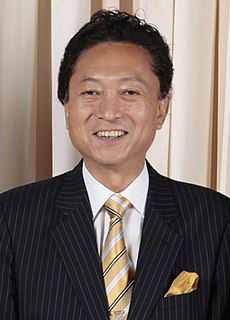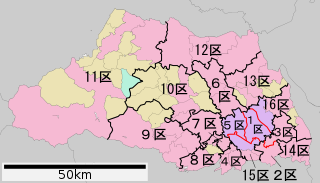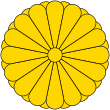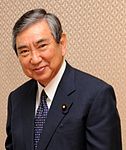
A general election for the Japanese House of Representatives was held on August 30, 2009. The opposition Democratic Party (DPJ) defeated the ruling coalition in a sweeping victory, winning 221 of the 300 electoral districts and receiving 42.4% of the proportional block votes for another 87 seats, a total of 308 seats to only 119 for the LDP.
Kyōto 5th district is a constituency of the House of Representatives in the Diet of Japan. It is located in Kyōto and covers the northwestern part of the prefecture on the Sea of Japan coast. The district consists of the cities of Fukuchiyama, Maizuru, Ayabe, Miyazu and Kyōtango as well as the Yosa District. As of 2012, 254,636 eligible voters were registered in the district.
Hyogo 11th district is a constituency of the House of Representatives in the Diet of Japan. It is located in Southwestern Hyōgo and is based on the 1995 borders of the city of Himeji; the former towns of Ieshima, Yumesaki, Kōdera and Yasutomi that merged into Himeji in 2006 are part of the 12th district. As of September 2015, 387,509 eligible voters were registered in the district.

Hokkaidō 5th district is a constituency of the House of Representatives in the Diet of Japan. It consists of Atsubetsu ward in Hokkaido's city of Sapporo and Ishikari Subprefecture without Sapporo. As of 2009, 453,752 eligible voters were registered in the district.
The Shikoku proportional representation block is one of eleven proportional representation (PR) "blocks", multi-member constituencies for the House of Representatives in the Diet of Japan. It consists of Shikoku region covering Tokushima, Kagawa, Ehime and Kōchi Prefectures. Following the introduction of proportional voting it elected seven representatives in the 1996 general election. When the total number of PR seats was reduced from 200 to 180, the Shikoku PR block shrunk to six seats.
Fukushima 3rd district is a single-member constituency of the House of Representatives in the Diet of Japan. It is located in Southern Fukushima and consists of the cities of Shirakawa, Sukagawa, Tamura and the Iwase, Nishishirakawa, Higashishirakawa, Ishikawa and Tamura counties. As of 2012, 293,378 eligible voters were registered in the district.
Niigata 5th district is a single-member electoral district for the House of Representatives, the lower house of the National Diet of Japan. It is located in the central, Chūetsu region of Niigata and covers parts of Nagaoka City, the cities of Ojiya, Uonuma, Minami-Uonuma as well as the former Minami-Uonuma County that, as of 2012, only has one remaining municipality: Yuzawa Town. As of September 2012, 282,904 voters were registered in Niigata 5th district, giving its voters above average vote weight.

Yamaguchi 4th district is a single-member electoral district for the House of Representatives, the lower house of the National Diet of Japan. It is located in Western Yamaguchi and consists of the cities of Shimonoseki and Nagato. As of September 2011, 266,456 voters were registered in the district, giving its voters well above average vote weight. Unlike many prefectures where the capital is also the most populous city, Yamaguchi's major city is Shimonoseki, located at the western tip of Honshū and part of the Fukuoka-Kitakyūshū metropolitan area.

The 47th general election of members of the House of Representatives of Japan was held on 14 December 2014. Voting took place in all Representatives constituencies of Japan including proportional blocks, in order to appoint Members of Diet to seats in the House of Representatives, the lower house of the National Diet of Japan. As the cabinet resigns in the first post-election Diet session after a general House of Representatives election, the lower house election also led to a new designation election of the prime minister in the Diet, and the appointment of a new cabinet. The turnout in this election is the lowest in Japanese history.
Shiga 2nd district is a single-member electoral district for the House of Representatives, the lower house of the National Diet of Japan. It covers Northeastern Shiga, today namely the cities of Hikone, Nagahama, Maibara, the dissolved towns of Aitō and Kotō in present-day Higashiōmi City and the former counties of Echi and Inukami. The district borders were redrawn in the 2002 redistricting and reapportionment, before that it had reached further to the South and covered Yōkaichi and Ōmihachiman cities and all of Echi, Kanzaki and Gamō counties. As of 2012, 264,168 voters resided in the district.

Yamaguchi 1st district is a single-member electoral district for the House of Representatives, the lower house of the National Diet of Japan. It is located in Yamaguchi and covers the prefectural capital Yamaguchi, parts of the city of Shūnan and the city of Hōfu. As of September 2012, 359,151 eligible voters were resident in the district.
The Hyogo at-large district is a constituency that represents Hyogo Prefecture in the House of Councillors in the Diet of Japan. It currently has five Councillors in the 242-member house, but this representation will increase to six by July 2019.
The Shikoku proportional representation block was one of 11 multi-member districts that were contested at the general election for the House of Representatives in the Japanese National Diet on 16 December 2012. Six seats were available for election via open party lists. The Liberal Democratic Party (LDP) won the election in a landslide, which returned former Prime Minister Shinzo Abe to power. In the Shikoku PR block, the LDP won two of the six seats with 30.7% of the vote.
A by-election for the Kyoto-3rd seat in the Japanese House of Representatives was held on 24 April 2016, coinciding with the by-election in Hokkaido. The seat became vacant after sitting member Kensuke Miyazaki resigned on 12 February 2016 in the midst of an extramarital affair scandal. Miyazaki, a member of the Liberal Democratic Party, served the district from 2012. He defeated Democratic Party MP Kenta Izumi by slim margins in the 2012 (0.1%) and 2014 (2.7%) elections.
The Niigata at-large district is a constituency that represents Niigata Prefecture in the House of Councillors in the Diet of Japan. It currently has three Councillors in the 242-member house, but this representation will decrease to two by July 2019.
The Ishikawa at-large district is a constituency that represents Ishikawa Prefecture in the House of Councillors in the Diet of Japan. It has two Councillors in the 242-member house.
The Shizuoka at-large district is a constituency that represents Shizuoka Prefecture in the House of Councillors in the Diet of Japan. It has four Councillors in the 242-member house.
The Kyoto at-large district is a constituency that represents Kyoto Prefecture in the House of Councillors of the Diet of Japan. It has four Councillors in the 242-member house.
A by-election for the Tokyo 10th district in the Japanese Japanese House of Representatives was held on 23 October 2016 to replace Yuriko Koike, who vacated the seat to contest the Tokyo gubernatorial election in July 2016. Koike, a member of the Liberal Democratic Party (LDP), had represented the district since the December 2012 general election and also served a previous term from 2005-2009. The election was won by LDP candidate Masaru Wakasa, an incumbent member for the Tokyo proportional representation block who had supported Koike during her gubernatorial campaign. A separate by-election for the Fukuoka 6th district was held on the same day.

Saitama 5th district is a constituency of the House of Representatives in the Diet of Japan. It is located in Saitama Prefecture and covers Nishi, Kita, Minuma, Ōmiya and Chūō wards of the city of Saitama.












